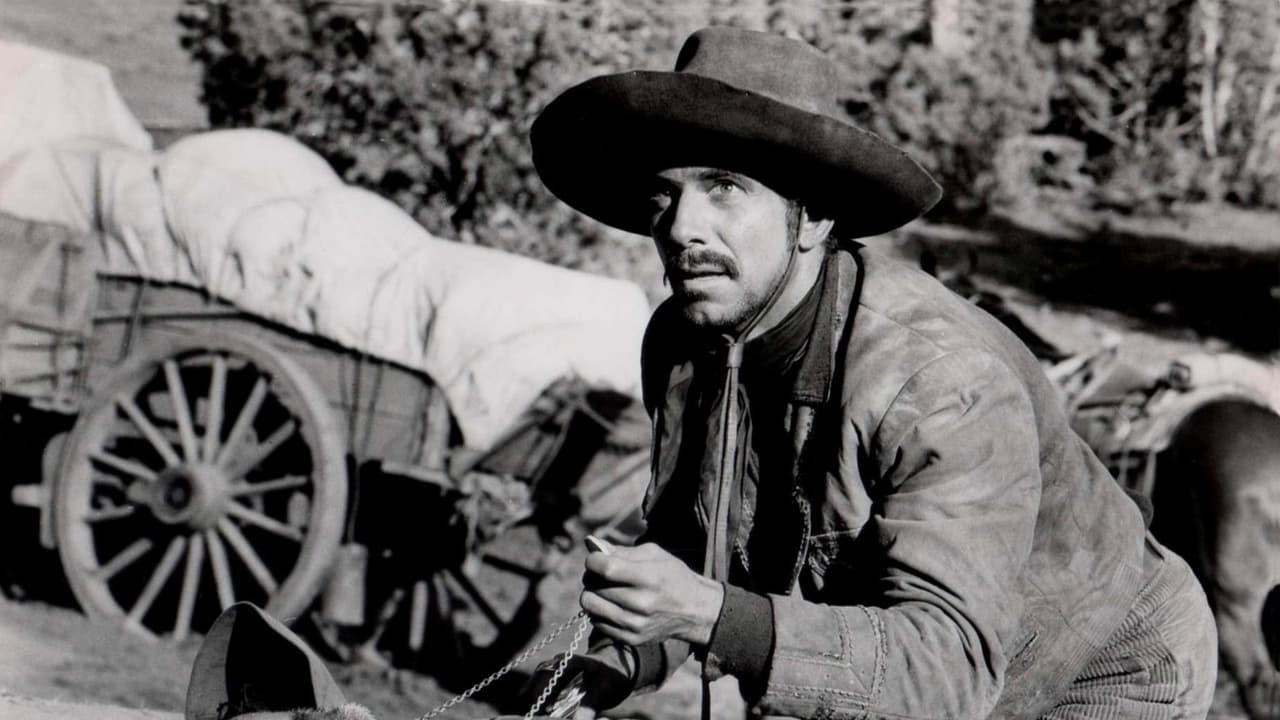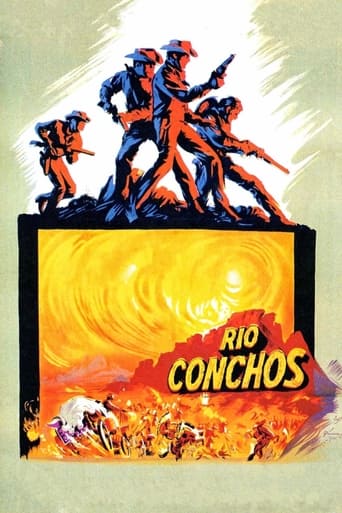Animenter
There are women in the film, but none has anything you could call a personality.
Salubfoto
It's an amazing and heartbreaking story.
Teddie Blake
The movie turns out to be a little better than the average. Starting from a romantic formula often seen in the cinema, it ends in the most predictable (and somewhat bland) way.
Phillipa
Strong acting helps the film overcome an uncertain premise and create characters that hold our attention absolutely.
Woodyanders
Angry and defiant ex-Confederate soldier Major James Lassiter (a splendidly gruff performance by Richard Boone) is forced to lead a small ragtag group into Mexico. While in Mexico Lassiter and company run across Colonel Theron Pardee (robustly essayed with fierce brio by Edmond O'Brien), a crazed megalomaniac Confederate soldier who's selling guns to a local tribe of Apaches. Director Gordon Douglas, working from a compact script by Joseph Landin and Clair Huffaker, relates the entertaining story at a swift pace, maintains a tough serious tone throughout, makes fine use of the dusty desolate dessert terrain, and stages the thrilling shoot-outs with rip-roaring aplomb. The sound acting from the excellent cast rates as a major plus: Stuart Whitman as the rugged Captain Haven, Jim Brown as the noble Sargeant Franklin, Wende Wagner as feisty Apache maiden Sally, and Rodolfo Acosta as bitter and formidable Native American chief Bloodshirt. However, Anthony Franciosa easily steals the whole show with his delightfully lively'n'lusty portrayal of vain, shifty, yet still oddly likable womanizing half-breed Juan Lois Rodriguez. The singular Timothy Carey has a neat and sizable uncredited role as hearty bartender Chico. A nice underlying theme concerning trust, loyalty, and betrayal gives the picture additional dramatic substance. Both Jerry Goldsmith's stirring full-bodied score and Joseph McDonald's sumptuous widescreen cinematography further enhance the sturdy quality of this enormously fun sagebrush opus.
Jeff (actionrating.com)
See it – This unheralded western classic is filled to the brim with rousing action. It has probably gone under the radar because it lacks a big name actor. But Richard Boone, Jim Brown, and Stuart Whitman are great in this old-fashioned, cowboys-on-a-mission movie in the same vein as "The Professionals." The mission in this one is to prevent Confederate desperadoes from selling repeating rifles to the Apaches. It's a little weird to see classic film villain Richard Boone as a good guy, but he carries the movie pretty well. The musical score is really good, and most of the movie has that "chase western" feel to it. But when things slow down at the end, you will only have enough time to take a deep breath before one of the best movie endings in the western genre.
Spikeopath
Rio Conchos is directed by Gordon Douglas and adapted to screenplay by Joseph Landon from the Clair Huffaker novel. It stars Richard Boone, Stuart Whitman, Jim Brown, Tony Franciosa, Wende Wagner and Edmond O'Brien. Music is scored by Jerry Goldsmith and Joseph MacDonald is the cinematographer. Out of 20th Century Fox it's a CinemaScope production filmed in De Luxe Color, and primary location used for filming was Moab, Utah.One ex-Confederate officer out for revenge against the Apache, one Army Captain driven by a sense of duty, one Buffalo Soldier continuing to prove himself and one Mexican convict getting a second shot at freedom. Four men, one journey, a mission to find who is arming the Apache with repeating rifles. Danger, mistrust and hostility are their only companions.The plot may be routine, and certainly it owes a debt to The Comancheros (Huffaker involved there too), but this is a tough and dark Western propelled by fine acting, quality direction and photography to die for. Structured around a men on a mission basis, each one with their own particular issues, it's very much a character driven piece. It's the time spent in the company of these men that makes the film so riveting, it never gets dull, the character dynamics are such, that we never quite know what to expect from the next part of the journey. Director Douglas also doesn't shy from action, pitting our odd group against Mexican Bandits and Apache Indians along the way, and then delivering a high octane finale that has a few twists and turns to keep it away from being formulaic.Whitman and Brown acquit themselves well enough, as does Wagner as the sole female of the piece. But acting wise this film belongs to Boone and Franciosa. The former portrays a bitter vengeful heart with ease, with a lived in alcoholic face, his destiny you feel is mapped out from the off. The latter shines as the ebullient character of the group, shifty, sly and as untrustworthy as it gets, Franciosa's play off of Boone gives the film its central pulse beat. But arguably all players are trumped by MacDonald's photography and Douglas' use of the scenery. From pretty much the first frame the landscape is the big character here. Douglas wisely using many long shots to reveal miles of vistas, then knowing when to pull in close to envelope the characters to give off the feeling of mental claustrophobia. Exterior work here belies the budget afforded the film, and all told it's a far better movie than the bigger produced Comancheros. Goldsmith's score is also a plus point, striking the mood from the get go, his arrangements flow at one with the hazardous destiny of the four men.One of the better 60's Westerns, it's in desperate need of a remastering job being done on it. 8/10
jpdoherty
The cavalcade of generally stunning 20th Century Fox Cinemascope/Color westerns that were produced in the fifties really came to an end with "Warlock" in 1959. The sixties saw a diminishing public appeal for them but during the new decade there were a few excellent examples of the genre still to come in the shape of RIO CONCHOS (1964), a reasonably good remake of "Stagecoach" (1966), the outstanding "Hombre" (1967) and the hearty "Butch Cassiday & The Sundance Kid" (1969). The latter two regretfully dropping the Cinemascope extension from the Fox logo and renaming the same process Panavision.After "Hombre" the best of them is by far RIO CONCHOS! A rugged rip roaring adventure in the best action packed tradition of the Hollywood western. Produced for the studio by David Weisbert the picture's basic premise gave an assertive nod to the studio's earlier "The Comancheros" (1960). Deriving from the novel by Clair Huffaker it was written for the screen by Joseph Landon and Clair Huffaker (who also wrote "The Comancheros"). The amazing Cinemascope cinematography came from genius cameraman Joe MacDonald and it was all solidly directed by the somewhat underrated Gordan Douglas.Richard Boone is Apache hating Major Jim Lassiter, late of the confederacy, who - with a furtive Mexican companion Rodriquiz (Tony Franciso) - is seconded into a Yankee undercover operation to find out where 2000 repeating rifles have disappeared to. Under the leadership of Captain Haven (Stuart Whitman) and his black Sgt.Franklyn (Jim Brown in his first movie appearance) Lassiter learns that his old Confederate commanding officer - the demented Colonel Theron Pardee (Edmond O'Brien) who is holed up on the Rio Conchos - is in possession of the guns and plans to arm the Apaches so as to reignite the Civil War. The mission is to thwart the Colonel's intentions and destroy the guns. In a marvellous set piece the picture ends literally in an explosive finale as the cache of arms goes up in a mushroom of smoke.Performances are generally good throughout. Whitman is fine in the lead in what is probably his best movie. But Richard Boone is a tad excessive in his playing. His Lassiter character is over-stylized even to the point where some of his scenes are rendered weak and unconvincing. However the acting honours has to go to Tony Francioso in one of the best roles he ever had. He is superb as Rodriquiz the wily, unscrupulous and womanizing Mexican. It is an Oscar winning performance! And there is an interesting bit of casting for an Indian girl played by the little known Wende Wagner. Here the actress perfectly creates an impressively authentic portrayal of a young Apache female.Conveying the action along is the terrific score by Jerry Goldsmith. Although he had previously written the music for a few westerns such as the forgotten "Black Patch" (1957) and his fine wistful effort for "Lonely Are The Brave" (1962) nothing before or after can compare to his work on RIO CONCHOS. It is a driving propulsive score! The main theme - first heard under the titles - is quite brilliant with the accordion gently introducing the tune accompanied by clunking banjo, guitar, scratcher comb and whip before the strings take up the tune to full flight. This cue is used later in an up tempo treatment for an escape and river crossing sequence with the strings screaming out the theme against repeated figures in the brass. The use of music here makes the scene simply breathtaking. There is also a plaintive reflective cue to characterize the Indian girl in a melancholy movement and there's some attractive indigenous folk tunes played on guitar for a Cantina sequence. RIO CONCHOS is Jerry Goldsmith's best score for a western!Jerry Goldsmith's music is just one exceptional element that makes RIO CONCHOS a remarkable, memorable and exciting action picture and gets my vote as one of the best westerns Hollywood ever conjured up.

